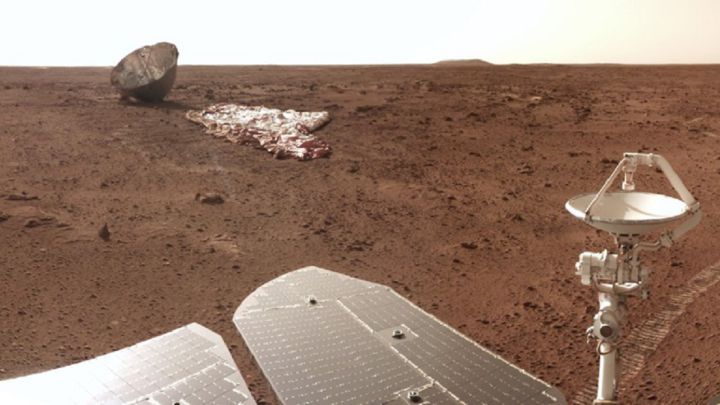The Chinese rover and the Tianwen-1 spacecraft have been gathering information on the Red Planet since February and have discovered revealing data.

Zhurong, the rover that China sent to Mars, and the Tianwen-1 spacecraft were from February to September collecting data on the climate, geology and history of the northern hemisphere of the Red Planet . Using cameras, a radar system, weather sensors and a laser spectrometer, they sent information daily to the National Astronomical Observatories of the Chinese Academy of Sciences (NAOC).
Some of these features that they have found on the surface, such as possible mud volcanoes and sedimentary material, hint at the historical flow of water . Therefore, scientists are looking for clues that confirm that there was once water or ice under the surface of the Martian planet. This discovery would have a “great scientific interest”, since it would show the existence of an ancient ocean , according to Bo Wu, a scientist at the Hong Kong Polytechnic University.
The initial forecast was that they would be only three months collecting information in a vast basin known as Utopia Planitia. But the mission exceeded expectations and Zhurong spent four more months than expected visiting items of interest on a journey of more than a kilometer. In September, the rover was put into hibernation , since when Mars passed behind the Sun in relation to the Earth, communication was lost. In October it was put into operation again, and it is looking for what could have been the coast of this ancient ocean .
Earth-like properties
This pause allowed Chinese scientists to begin analyzing the information. The dataset includes images from the Zhurong navigation camera; climatic data on temperature, pressure and wind speed; information on the chemical composition of rocks, soil and sand dunes from a laser spectrometer ; and tracks from below the surface of your ground penetrating radar.
Being China’s first mission on the surface of another planet, it slows down the processing and cleanses of the data, since ” there is a learning process “, as Lu Pan, a scientist at the University of Copenhagen, affirms. Furthermore, unlike NASA, the data collected by all the instruments on the rover and the spacecraft is first processed by the NAOC and then divided among multiple teams of scientists linked to the mission , contributing to the slowdown.
However, the first studies have already been published. One of them, who analyzed the images and information on friction obtained from the movement of Zhurong’s wheels, shows that the regions through which it passed have properties similar to those of the compact and sandy soil of the Earth . This could be helpful in “understanding how soil and dust formed” on the surface, according to Xiao Long, a geologist at the China University of Geosciences in Wuhan.
International publication and next phase
Until now, the data has only been shared with researchers who are directly involved with the mission, but at some point it will be released to the international community . This could help speed up the analysis, as scientists with more experience on Mars could recognize features of interest and their meaning more quickly.
Now, Zhurong will continue to explore the terrain, probably for years . Meanwhile, Tianwen-1 is no longer just a communications relay between the rover and Earth, but also conducts its own observations of Mars. In addition, the CNSA and the European Space Agency (ESA) are testing whether ESA’s Mars Express orbiter could be used to transmit the Zhurong data to Earth .
